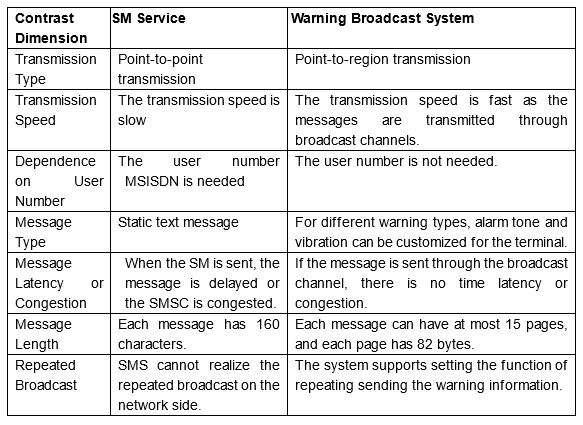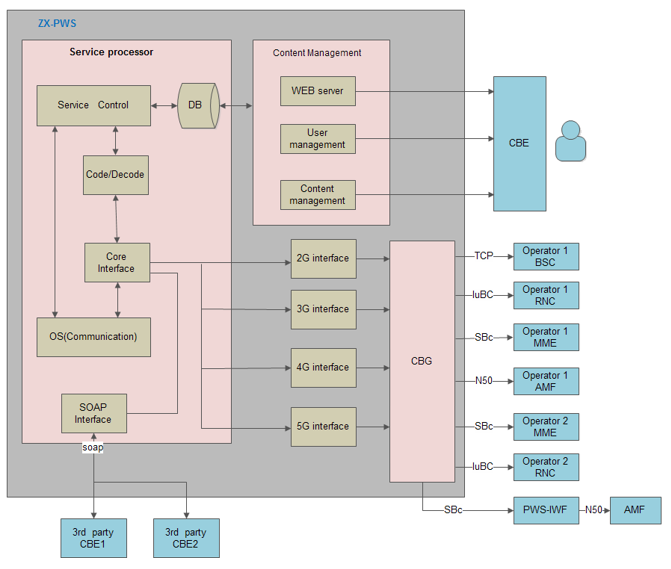Public safety has become an important guarantee for both the normal development of economy and society and the normal operation of national management in various countries. To prevent human being from being harmed by sudden major natural disasters, the governments of all countries are researching public warning systems. The PWS (Public Warning System) introduces the method of transmitting warning notifications in a timely manner to mobile subscribers who need to be transferred and evacuated immediately due to major emergencies in multiple regions or one region. The PWS, which is supported by the terminal, can display alarms of different types such as ETWS (earthquake, tsunami) and CMAS (Commercial Mobile Alert System). When the user receives the alarm message, the message will automatically pop up and play the specific alert alarm tone, so that the user can get the alarm information quickly and in time.
In recent years, governments in different places have started to require operators to build warning systems for public incidents to avoid major losses caused by emergencies. South America, EU and Hong Kong have made clear legislation, requiring operators to construct public warning systems and mobile terminals sold locally to support PWS service functions.
Compared with traditional short messages, the warning broadcast system has the following service features:

Technical Requirements Faced by the PWS Construction
As a public warning service platform oriented to the society, the PWS faces the following challenges and technical requirements when the government/operator constructs this platform:
- Unified operator network access: One platform accesses all operator networks in the country or region to facilitate the government or the public emergency center to rapidly send the warning information to all the operator’s users in the region.
- Multi-mode network access: Different operators may coexist in the 2G/3G/4G/5G networks. It is necessary to ensure that the terminals of different modes can receive the alarm messages from the emergency center.
- Flexible management of the broadcast area: The system supports the free selection of specific target area, fixed administrative area and whole network area for broadcasting the message.
- Simple and easy-of-use of CBE (Cell Broadcast Entities): For end users, the network type, operator and radio configuration data should be transparent so that the public warning emergency center can use the system easily.
- Multi-CBE access: The system requires the capability to access a variety of emergency information distribution centers, such as earthquake bureaus, marine bureaus, meteorological bureaus and police stations, for releasing different types of warning information.
- Deployment in multiple ways: The PWS needs to support the deployment in cloud mode or physical machine mode flexibly for different sites.
- Timeliness of sending the warning message: The warning message needs to be sent to the user terminals in the target area within a very short period of time (such as 10 seconds). Considering the performance of the wireless equipment, the warning message cannot be sent to the wireless equipment with great impact.
ZTE Realizes PWS Based on the Innovative Service Platform
Based on innovative service platform, the ZTE PWS provides an integrated solution for the application layer of telecom network, and supports accessing multiple telecom network protocols, such as INAP, MAP, WIN, CAP, Diameter, SMPP, CBC-BSC, Iu-BC, SBc and N50. This innovative service platform solution can provide enterprises and individuals with rich voice, message and multimedia value-added services in 2G/3G/4G/5G networks, such as VPBX, IVR, USSD, Call Assist, PWS, prepaid and RBT value-added services.
ZTE has a deep understanding of the requirements of the governments and the operators for public warning. Based on years of reliable design experience of telecom equipment and mature innovative service platform, ZTE has launched a new-generation PWS emergency warning system to help the government and the operators implement rapid deployment of the emergency warning system and provide high-performance and reliable public warning services.
The ZTE PWS has the following system architecture:

Figure 1 ZTE PWS Architecture
The ZTE PWS supports the following deployment modes:
- Supports NFV cloud deployment, reducing the operator's TCO of deploying the system on demand.
- Supports virtualized deployment so that the system can share VM resources with other services to reduce CAPEX.
- Supports automatic and rapid service deployment, shortening service provisioning TTM;
- Supports the deployment of physical machines by providing the physical machine deployment solution for the customers who do not have the virtualization environment.
The ZTE PWS can realize the following functions:
- The system provides the integrated CBG (Cell Broadcast Gateway) broadcast gateway: It can interconnect with multiple PLMNs and multiple operator networks. Only one system is needed to interconnect all operators and all system wireless networks.
- The system supports the interface capability of multiple network systems: It has the traffic limiting function for different single network devices to adapt to the processing capability of the wireless equipment, and supports the configuration of different maximum traffic functions for different BSC/RNC/MME/AMF devices.
- The system supports the management of automatic wireless warning broadcast data: It provides the capability of automatic loading and updating wireless warning broadcast data, and synchronizes wireless data to ensure CBC (Cell Broadcast Center) data update.
- The system provides external SOAP interface capability: It supports multi-third-party CBE (Cell Broadcast Entities) access via standard SOAP interface, and provides the CBC (Cell Broadcast Center) broadcast function.
- The system supports flexible broadcast area management function: The built-in CBE content management function provides multi-dimensional broadcast area management and selection functions. Users are allowed to select specific predefined areas, administrative areas, and whole network areas to publish warning messages. It provides the capability of interconnecting with the Google map, and allows users to select a specific geographical area (such as a circle, a rectangle, or a polygon) for sending messages by invoking the map API.
- The system can select the adaptive broadcast mode. For 4G/5G networks, 3GPP specifies multiple broadcast modes including CGI, TAI and Emergency area broadcast modes. For large-area or network-wide broadcast modes, the system adaptively selects the TAI or emergency area mode to ensure fast broadcast of messages to the whole network and avoid mass data transmission in cell broadcast mode.
- The system supports the large capacity and high concurrency message transmission. A maximum of 100 WRITE-REPLACE messages can be sent per second in packet. It also supports the configuration of the maximum number of Cell List messages based on alarm messages to meet the BSC/RNC/MME/AMF's requirements for alarm message processing.
As the world's leading provider of integrated communications solutions, ZTE Telecom's value-added service systems have been serving more than 1 billion users from 110 operators in 1,600 offices in over 90 countries, and have been recognized by many multinational operators.
Based on the innovative service platform, the ZTE PWS has successfully provided stable and reliable public warning services for operators and governments in many countries and areas around the world. With the importance attached to public warning services around the world, the ZTE PWS will continue to innovate and work with global operators and governments to provide better public warning services for users.
ZTE supports AI with full-stack IT offering
5GC Green Engine Solution to Enable Green Internet of Everything in the Dual-Carbon Era
5GC Private Network 2.0 Empowerment and Efficiency Improvement Boosts High-Quality Development of the Industry
5G Empowers Intelligent Mining for High-quality Development of Shaanxi Coal Caojiatan Mining
ZTE and China Mobile embrace digitalization for biodiversity conservation in Panda Reserve
Three Aspects Contribute to ZTE’s Remarkable Breakthroughs in Advanced G4X Server
How 5G Private Networks Are Poised to Transform Enterprises Worldwide: All Scenario Private 5G Helps Operators to Realize Private 5G as a Service
ZTE’s commitment to servers generates robust growth of up to 60 times in past 8 years
ZTE eyes top 5 global server market share
Full-Scenario One-Stop 5G Private Network for Vertical Industries

